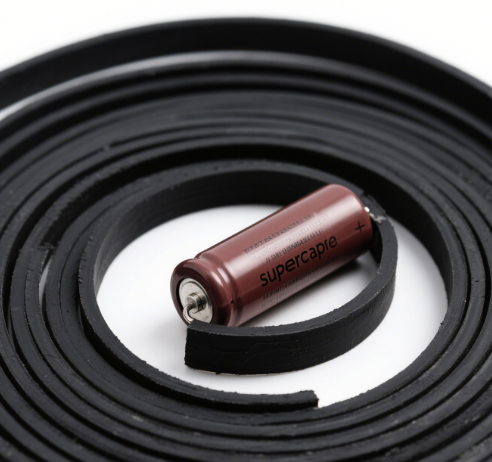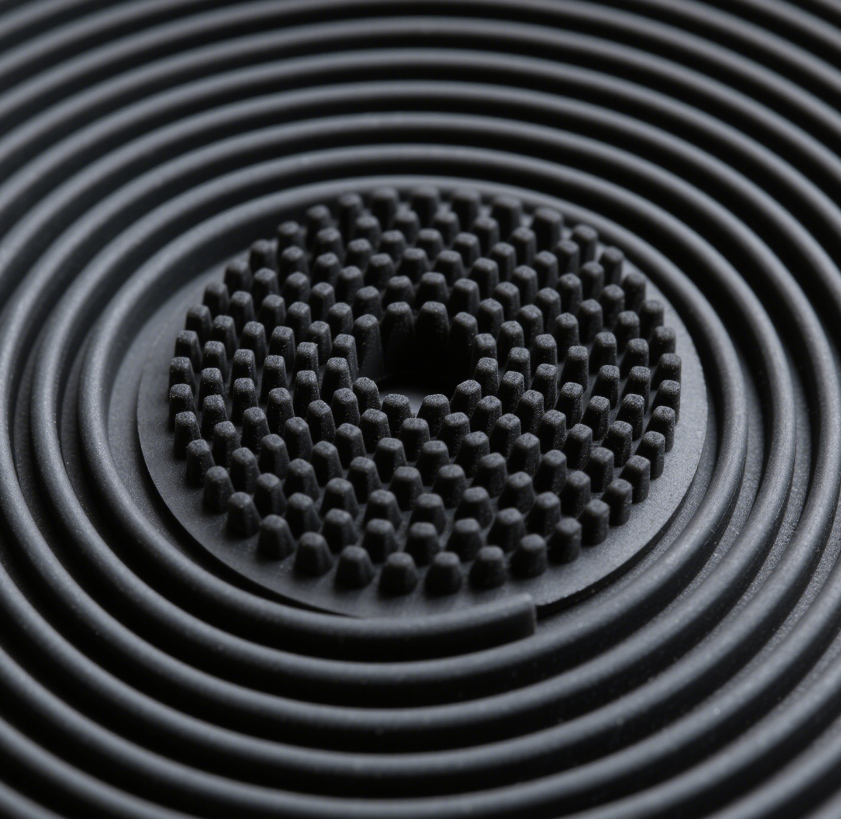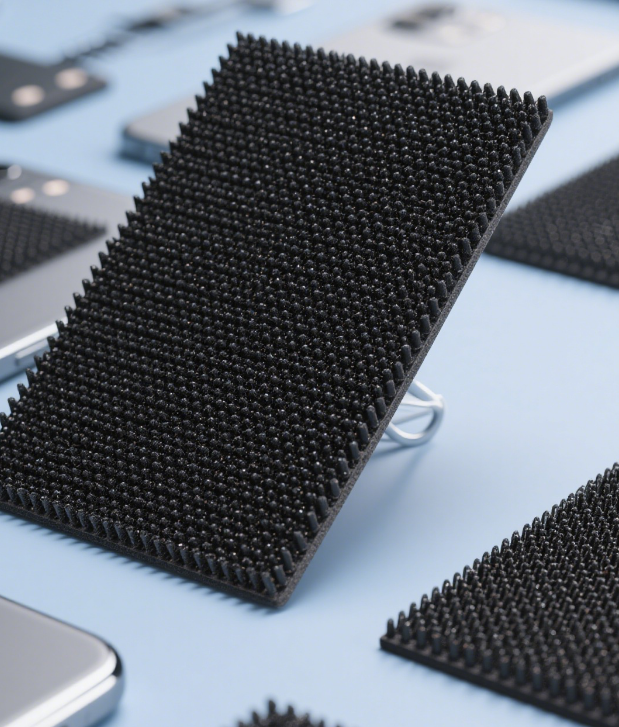conductive rubber for soft robots
 Conductive rubber for soft robots is a kind of intelligent material that combines the flexibility of rubber with electrical conductivity. By adding conductive fillers (such as carbon black, metal particles, nanomaterials, etc.) to the elastomer matrix, it has both the ability of deformation and the function of electrical signal transmission. The following analysis will be carried out from aspects such as material characteristics, application scenarios, technological breakthroughs, and challenges:
Conductive rubber for soft robots is a kind of intelligent material that combines the flexibility of rubber with electrical conductivity. By adding conductive fillers (such as carbon black, metal particles, nanomaterials, etc.) to the elastomer matrix, it has both the ability of deformation and the function of electrical signal transmission. The following analysis will be carried out from aspects such as material characteristics, application scenarios, technological breakthroughs, and challenges:
- Core Characteristics and Material Design
Conduction Mechanism and Filler Selection
The electrical conductivity of conductive rubber originates from the electron conduction between the fillers. Common fillers include:
Carbon-based Materials: Such as acetylene black, graphene, and carbon nanotubes (CNT). They have low cost and good compatibility, but relatively weak electrical conductivity. For example, the HAEC₇-T rubber developed by Guangxi University constructs a continuous conductive network through CNT, and its volume resistivity is as low as 0.1 Ω・cm.
Metal-based Materials: Such as silver powder and silver-plated copper particles, which have excellent electrical conductivity (the volume resistivity can be as low as 0.002 Ω・cm), but are costly and prone to oxidation. The PneuAct soft robot of MIT uses silver-plated yarns to achieve the dual functions of resistive pressure sensing and capacitive sensing.
Composite Fillers: Such as the structure of melamine cyanurate sponge / polydopamine / copper layer. The copper layer is evenly deposited on the porous skeleton through electroplating technology to improve the electrical conductivity and stability.
Optimization of Mechanical Properties
Multiple Cross-linked Networks: The HAE-T rubber of Guangxi University achieves a 100-fold increase in mechanical strength and a cross-linking density of 1444 times through covalent and non-covalent cross-linking. It is resistant to environmental erosion such as ultraviolet rays, acids, and alkalis.
Coupling Agent Modification: Adding silane coupling agents can enhance the interfacial bonding between the filler and the rubber matrix, reduce stress concentration, and improve the high-temperature resistance at the same time. For example, the conductive rubber with 0.7% coupling agent still maintains stable electrical conductivity at a high temperature of 180℃.
- Key Application Scenarios
Flexible Sensors and Actuators
Tactile Sensing: The PneuAct robot of MIT uses a “sweater” woven with conductive yarns to achieve resistive pressure sensing (detecting the grasping force) and capacitive sensing (perceiving touch), with an accuracy of 1-2 kΩ.
Drive Control: Conductive rubber can be used as the electrode of a pneumatic actuator. For example, in the electrohydrodynamic-driven soft robot of Zhejiang University, the conical array – porous plate electrode pair is used to increase the response speed to more than 20 Hz.
Wearable Devices and Medical Robots
Exoskeleton Gloves: The PneuAct gloves assist finger rehabilitation through the tactile feedback of conductive rubber, reduce muscle activity, and are suitable for trauma patients.
Medical Catheters: Conductive rubber can be integrated with pressure sensors to monitor the changes in internal pressure in real time, and is used for endoscopes or minimally invasive surgical tools.
Energy and Environmental Fields
Triboelectric Nanogenerators: The RECE-TENG prepared from the HAEC₇-T rubber of Guangxi University can stably output electrical energy in harsh environments and supply energy for soft robots.
Self-healing Electronic Skin: The self-healing liquid developed by Zhejiang University can quickly fill large-area damages. The stretched ratio of the repaired silicone rubber can reach 700%, providing self-protection ability for soft robots.
III. Technological Breakthroughs and Innovations
Innovation of Manufacturing Processes
3D Printing and Knitting Technologies: The integrated design system of MIT directly weaves conductive yarns through an industrial knitting machine to quickly generate complex structures, supporting the automated production of tubular actuators.
Vacuum Impregnation Method: The filler of melamine cyanurate sponge / copper layer is compounded with silicone rubber through vacuum impregnation to improve the uniformity of the conductive network.
New Material Systems
MXene Composite Materials: The Zn-CAT/IPMC driver of Xi’an Jiaotong-Liverpool University combines two-dimensional conductive MOF materials to achieve ultra-fast response (1.56 seconds) and high driving strain (2.38%).
Carbon Nanotube-modified Fluororubber: The patented technology of Xiamen Huatan Technology enhances the fluororubber through carbon nanotubes, improving the electrical conductivity and mechanical strength, and is suitable for high-temperature environments.
Self-healing and Intelligent Integration
Self-healing Liquid: The self-healing liquid of Zhejiang University can be cured within 10 seconds at 250℃ to repair the damaged silicone rubber, with a stretched ratio > 1200%.
Electronic Skin Layer: Integrating the resistor network and heating function, it realizes the integration of damage sensing and self-healing, and improves the environmental adaptability of the robot.
- Challenges and Future Directions
Core Challenges
Balance between Electrical Conductivity and Elasticity: A high filler content (such as silver powder) will reduce the elasticity, and it is necessary to optimize through the design of nanostructures (such as porous fillers).
Environmental Stability: Conductive fillers are prone to oxidation in high-temperature and high-humidity environments. Coupling agents and surface coating technologies can improve this situation, but the long-term reliability still needs to be verified.
Mass Production Cost: Metal fillers and complex processes (such as electroplating) lead to high costs. The substitution of recycled rubber and carbon black can reduce the cost, but it will sacrifice some performance.
Future Trends
Multifunctional Integration: Integrating sensing, driving, and energy harvesting functions, such as the triboelectric nanogenerator of Guangxi University.
Biocompatibility: Developing medical-grade conductive rubber for implantable devices or biomedical robots.
Intelligent Design: Combining machine learning to optimize the material formula and structure, and realizing adaptive deformation and self-healing.
- Typical Cases and Data Comparison
Material Type Conductive Filler Volume Resistivity (Ω・cm) Tensile Strength (MPa) Application Scenarios R&D Institution
Silver-filled Silicone Rubber Silver powder 0.002 1.38 Electromagnetic shielding, precision sensors China Electronics Technology Group
Carbon Nanotube-modified Fluororubber Carbon nanotubes 0.1 3.80 High-temperature environment, industrial robots Xiamen Huatan Technology
Melamine Cyanurate Sponge / Copper Layer Copper coating 0.004 2.07 Flexible electronics, wearable devices Guangxi University
Conductive Yarn (Acrylic + Silver-plated) Silver-plated fiber 1-2 kΩ (resistance) N/A Tactile sensing, pneumatic actuator MIT CSAIL
Conclusion
As the core material of soft robots, conductive rubber shows great potential in fields such as flexible electronics, medical rehabilitation, and energy harvesting. In the future, it is necessary to break through the bottlenecks of electrical conductivity, stability, and cost through material innovation (such as MXene, self-healing liquid), process optimization (such as 3D printing, vacuum impregnation), and intelligent design, and promote the development of soft robots towards high adaptability and multifunctionality.
















